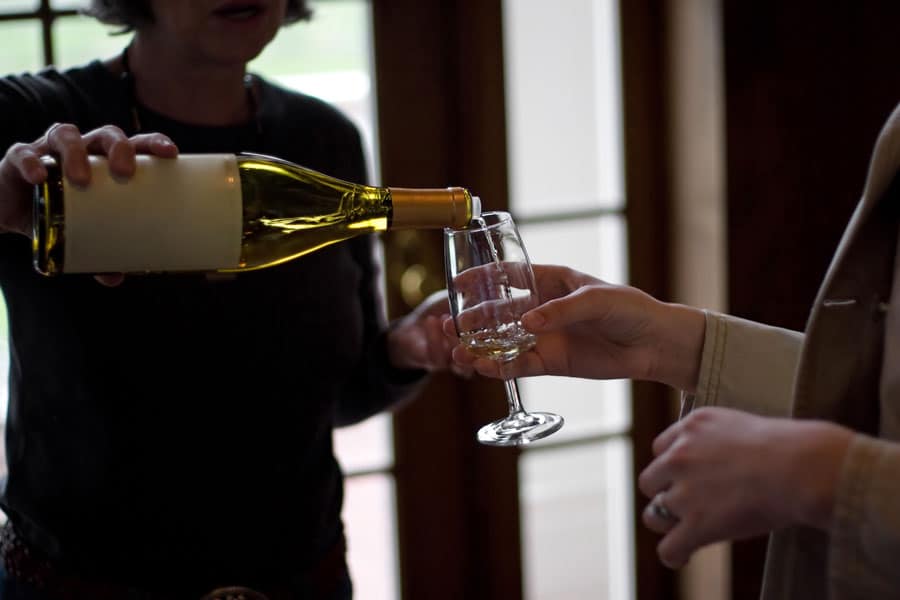
Humans have been making and drinking wine for thousands of years—and somewhere along the way, wine picked up an aura of class, culture, and “I totally know what I’m doing.” If you’re new to tasting rooms, that can feel a little intimidating… like you’re one wrong swirl away from embarrassing yourself.
Good news: you don’t need a secret handshake, a fancy vocabulary, or a sommelier certification to enjoy a Napa Valley wine tasting. What you do need is a little preparation, a few easy techniques, and the kind of respectful, curious attitude that tasting room staff love.
This guide will walk you through how to taste wine in Napa Valley, including what to do before you arrive, tasting room etiquette, the step-by-step tasting process, and answers to common first-timer questions—so you can sip confidently and have a genuinely great time.
How to Taste Wine in Napa Valley (The Big Idea)
A Napa tasting is more than “drinking wine.” You’re sampling the hard work, experience, and creativity of a vineyard team—often poured by someone who’s proud of what’s in that glass. The simplest “rule” is this:
Respect the wine, the vineyard, and the people who made it.
As long as you show up ready to appreciate the experience (and not turn the tasting room into a party bus), you’ll be welcome almost anywhere.
Before You Go: Simple Prep That Makes You Look Like a Regular
A smooth tasting day starts at home. Here’s what to do before you hit the vineyards.
1) Check tasting policies (and book ahead)
In Napa Valley, many wineries run tastings by appointment, especially on weekends and during peak season. Even if a place accepts walk-ins, reservations often mean:
- less waiting
- a better host experience
- a more relaxed pace
If you’re traveling with a group, it’s extra important to book ahead—many wineries have strict group-size limits.
2) Eat first (seriously)
You don’t need a five-course meal, but don’t arrive on an empty stomach. Tastings often include small bites or crackers, but those are meant to reset your palate, not replace lunch.
A good pre-tasting plan: something with protein + carbs (sandwich, eggs and toast, tacos, etc.) so you’re steady and comfortable.
3) Hydrate like it’s your job
Bring water in the car and sip throughout the day. Napa tastings can be spaced out, sunny, and surprisingly dehydrating—even if you’re “only tasting.”
4) Plan transportation in advance
If you’re tasting, assume you shouldn’t drive much—especially if you’re visiting multiple wineries. Options include:
- a designated driver
- rideshare (works best in the busier corridor towns; less reliable in remote areas)
- a hired driver or guided wine tour
- a group shuttle service
Your future self will thank you for having a plan before the first pour.
5) Bring a cooler for bottles
If you think you’ll buy wine, keep a small cooler with ice packs in the car. Heat is not a wine’s best friend, and Napa afternoons can be warm even when it feels breezy.
6) Bring something to take notes (or use your phone)
If you taste 8–12 wines in a day, your memory turns into a delicious blur. Notes help you remember what you loved—and why you loved it.
A quick note format that works:
- Winery + wine name/vintage
- 3 words you notice (fruit, spice, texture)
- “Buy / maybe / pass”
7) Skip perfume/cologne and strong scents
This is the easiest “pro move.” Aroma is a huge part of taste, and strong fragrances can affect:
- your own experience
- your neighbors’ experience
- the host’s ability to guide you
Napa Valley Wine Tasting Etiquette (Easy Rules, Big Payoff)
No need to be formal. You just want to be a pleasant, engaged guest.
Be friendly and present
Say hello, put your phone down when your host is talking, and treat the tasting like a mini experience—not something to rush through like errands.
Don’t get overly drunk
Tasting rooms aren’t trying to police fun; they just want a comfortable environment. If someone becomes loud, sloppy, argumentative, or unsafe, it pulls attention away from the wine and the experience for everyone.
The easiest way to stay in the sweet spot:
- drink water between pours
- eat during the day
- use the spit bucket when needed
- slow down
Ask questions (the good kind)
Your host wants you to ask about:
- the vineyard and winemaking process
- the grapes and how the wine was aged
- what makes this bottle unique
- pairing suggestions
- what else to try if you like/dislike a wine
Try to avoid broad, “Wine 101” questions you could easily Google later. Tasting rooms shine when the conversation stays connected to their wines and place.
Talk about what you taste (in your own words)
You don’t need to say “wet slate” or “forest floor.” If you taste “cherry,” “vanilla,” “lemon,” “pepper,” “butter,” or even “this reminds me of pie”—that counts.
Sharing impressions with friends often helps you notice flavors you would’ve missed on your own.
Be honest (kindly)
If you don’t love a wine, you can say something like:
- “This one’s a bit too oaky for my taste—what would you recommend that’s brighter?”
- “I usually like lighter reds—do you have something more in that style?”
That helps your host guide you toward a wine you’ll genuinely enjoy.
Try what’s offered (even if you “don’t like” that style)
A winery’s version of a grape can surprise you. That said, if you have a hard no (very sweet wines, for example), it’s okay to share preferences early so your host can tailor the lineup.
Spitting is normal (and respected)
Using the spit bucket doesn’t mean you disliked the wine. It often means you’re pacing yourself so you can taste thoughtfully—especially with higher-alcohol reds, multiple wineries, or a long day.
If you love it, consider buying a bottle
Compliments are wonderful, but purchases keep wineries running. You don’t need to buy something at every stop, but if a place truly impresses you, taking home a bottle is a great “thank you.”
Bonus tip: if you really love a winery, ask about:
- bottle shipment options
- member perks (wine clubs can include waived tasting fees, discounts, or allocations)
How to Taste Wine Step-by-Step (Like a Wine Critic, Minus the Pretension)
Here’s a simple, repeatable method you can use at every tasting. It’s easy, it works, and it makes wine more fun.
1) Look
Hold the glass by the stem (helps keep the wine at the right temperature and keeps the bowl clean).
Then take a moment to observe:
- color intensity (pale vs deep)
- clarity (bright vs hazy)
- rim variation (especially with reds)
Look straight down from above, then from the side. No pressure to “interpret” everything—just notice.
2) Swirl
Swirling releases aromas by increasing contact with air.
If you’re new to swirling:
- keep the base of the glass on the table
- make small circles
- don’t rush
3) Smell
After swirling, take a few short sniffs just over the rim.
Try to identify familiar categories:
- fruit (berry, citrus, stone fruit, tropical)
- herbs/spice (pepper, clove, thyme)
- floral (rose, violet)
- oak/aging notes (vanilla, toast, caramel, cedar)
If you can’t name anything specific, that’s fine. Even noticing “fresh,” “bright,” “rich,” or “earthy” is useful.
4) Sip
Take a sip big enough to coat your mouth. Let it move across your tongue.
Some people do a small “sip and slosh.” Others pull in a tiny bit of air (the classic tasting-room “sllrrp”). Use whatever feels comfortable—the goal is to notice detail.
5) Notice structure (the “feel” of the wine)
This is where wine starts to make sense quickly. Pay attention to:
- Sweetness: dry, off-dry, sweet
- Acidity: makes your mouth water; feels bright or crisp
- Tannin (reds): dries your gums; feels grippy
- Body: light, medium, full
- Alcohol warmth: subtle glow vs noticeable heat
You don’t need perfect terms—just notice what stands out.
6) The finish
After swallowing (or spitting), pause and observe:
- What flavors linger?
- How long do they last?
- Do you want another sip?
A long, pleasant finish is often a sign of quality—but the best wine is still the one you enjoy.
7) Reset your palate
Between wines, use:
- water
- crackers/bread (if offered)
- small bites (if included)
This keeps each pour distinct so you’re not tasting “the last wine” instead of the current one.
Common Napa Wine Tasting Mistakes (Easy to Avoid)
A quick checklist of what not to do:
- wearing strong perfume/cologne
- arriving hungry and getting lightheaded fast
- rushing through pours like a stopwatch is running
- talking over your host’s explanation
- turning a tasting room into a party vibe
- forgetting to drink water all day
- buying bottles and leaving them in a hot car
Nail these basics and you’ll feel like you’ve done this a hundred times.
FAQ: Napa Valley Wine Tasting Questions
Do you tip at a wine tasting in Napa Valley?
Not necessarily. In many Napa tasting rooms, tipping isn’t expected the way it is in a restaurant, and some wineries don’t accept tips at all.
If tipping is permitted and you had an exceptional host, a modest gratuity is a kind gesture. Other great ways to show appreciation:
- buy a bottle (or two)
- leave a positive review mentioning your host by name
- tell a manager when someone made your experience special
How much wine do you get at a wine tasting?
It depends on the winery and the tasting format, but a common setup is:
- a flight of 3–5 wines
- pours around 2–3 ounces each
Some experiences include more wines, library pours, or elevated tasting formats (often paired with food). You can usually ask for a small re-pour of a favorite, but it’s best to keep it balanced—your palate is your superpower, and it works best when you’re not overdoing it.
Final Sip: You’re Going to Do Great
The “secret” to wine tasting in Napa Valley isn’t fancy language—it’s curiosity, good manners, and slowing down enough to notice what’s in the glass. Prepare a little, pace yourself, ask thoughtful questions, and don’t be shy about spitting when you need to.
Most importantly: enjoy it. Napa is one of the most welcoming wine regions in the world, and every expert you’ve ever met started with their very first tasting—just like you.
Vacation-Napa is a trusted source for travel information, providing expert tips and insights on Napa Valley’s wine culture and tourism.
